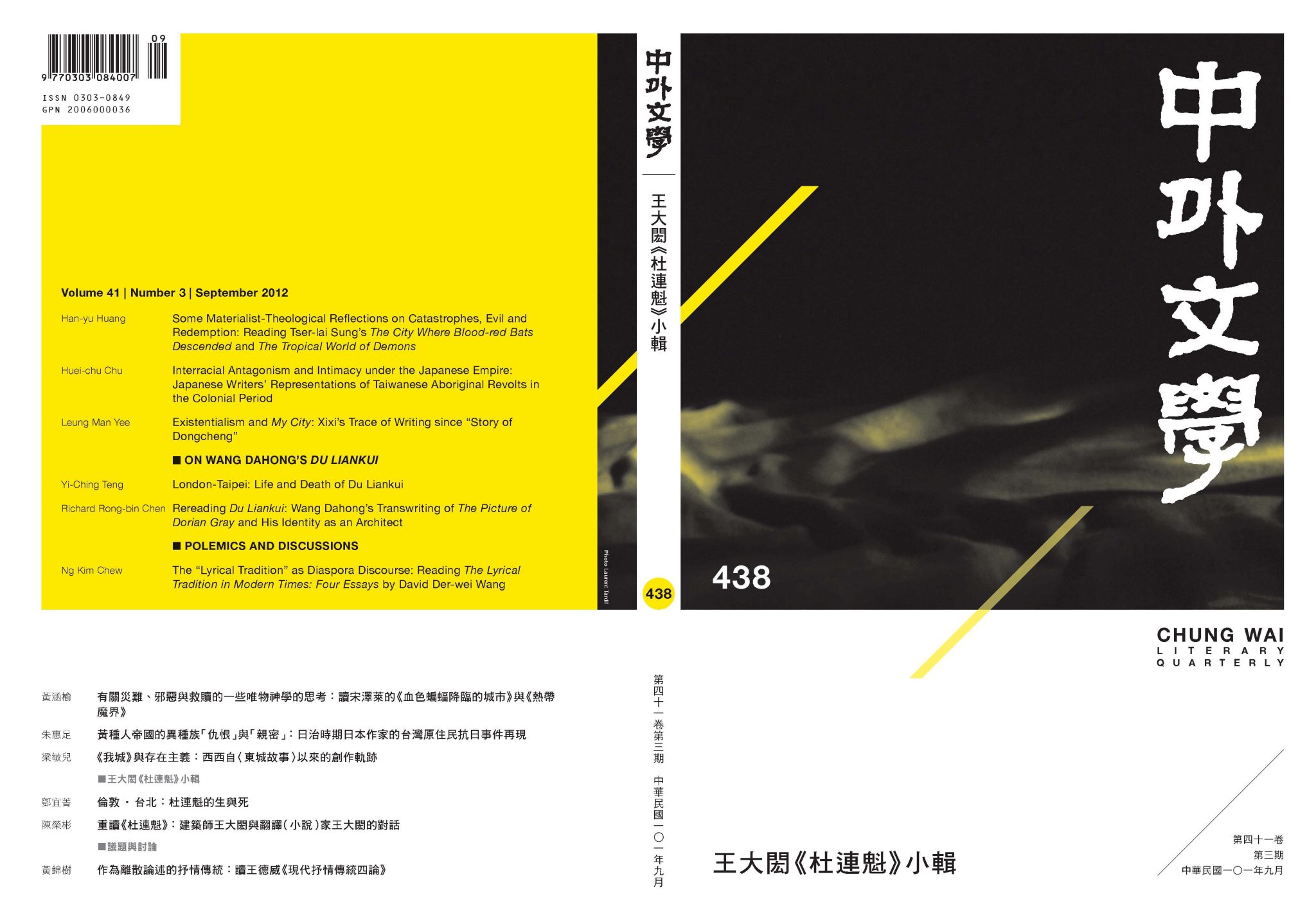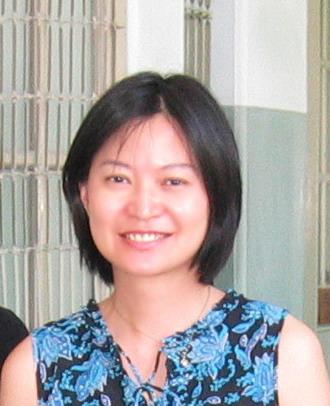第四十一卷 第三期 總438 中華民國101年9月
Vol.41 No.3 September 2012

《中外文學》九月號除了刊登三篇一般論文,也收錄了兩篇專題論文,探討建築師王大閎翻譯/改寫自王爾德《葛雷的畫像》(The Picture of Dorian Gray)的小說《杜連魁》,以及一篇深度書評。「一般論文」部分,黃涵榆嘗試以唯物神學觀點來閱讀宋澤萊的小說《血色蝙蝠降臨的城市》與《熱帶魔界》,析論小說中邪惡的問題,並檢視小說中的神學經驗,以求開展更為寬廣深入的視野;朱惠足以日治時期四個日本作家取材於台灣泰雅族原住民抗日事件的文學創作切入,探討這些台灣原住民再現中「野蠻」與「文明」之間的辯證過程,是如何呈現出日本帝國的種族論述在西方視線下的屈折性質;梁敏兒則認為西西的小說直到《我城》仍深受存在主義創作的影響,主要以加謬的《局外人》和《薛西弗斯的神話》,分析其在西西的作品中如何不斷進行創造性演化。在本期「王大閎《杜連魁》小輯」的部分,鄧宜菁分析《杜連魁》徘徊於翻譯與改寫之間,在故事譯(異)寫再生的過程中,自我與他者如何相互角力、辯證,展現歷史與敘事、時間與空間的雙重建構;陳榮彬則從巴赫汀(Mikhail Bakhtin)的「時空體」概念出發,主張《杜連魁》扮演了為建築師王大閎代言的角色,其都市願景終究是一種對於美的追求,且是以自然為最後依歸的美。
中外文學九月號目錄
Contents
編輯室報告
Editorial Note
- 朱偉誠╱編輯室報告
Wei-cheng Chu╱Editorial Note
黃涵榆╱有關災難、邪惡與救贖的一些唯物神學的思考:讀宋澤萊的《血色蝙蝠降臨的城市》與《熱帶魔界》
有關災難、邪惡與救贖的一些唯物神學的思考
讀宋澤萊的《血色蝙蝠降臨的城市》與《熱帶魔界》
黃涵榆*
摘要
自八○年代以來,宋澤萊的小說慣用以魔幻寫實的手法,描繪神學與宗教意味濃厚、深富政治與文化批判目的的災難與鬼神意/異象。即便到目前為止已有不少這方面的評論,但大多欠缺較為完整連貫的理論架構,以統合處理小說中的神學靈視、善惡爭鬥、集體行動與救贖希望。針對這些不足之處,本文將開展唯物神學觀點來閱讀宋澤萊《血色蝙蝠降臨的城市》與《熱帶魔界》。第一部分將對現有的一些主要的研究進行評述,著眼於美學形式風格與激進的神學思考及政治文化批判的密切關連,並指出不應以對號入座的方式視小說為作者「個人的」宗教信仰歷程之無縫的對應與再現,甚至是套入藍綠、統獨、外來本土、台灣中國的意識形態光譜。第二部分透過「歪像」(anamorphosis)的理路構築神學靈視的理論基礎,要強調的是一種非主體中心論的、牽涉到身體的實質變異以及本體性斷裂或失序的經驗(而非只是單純的觀點或認知的轉換),以此分析小說中有神學靈視體驗的角色如何參與對抗邪惡與現實改造的行動。本文接下來將進一步藉由謝林(F. W. J. von Schelling)哲學,鋪陳出紀傑克唯物神學的理路,著眼於對現實物質世界有著激進極端關懷的神學的介入,而非通往超越性的域外或所有矛盾衝突終告消解的空靈的、虛無的、亦是封閉的世界。本文以此理路分析小說中邪惡的問題,並且「檢視」、而非「印證」小說中的神學經驗,開拓有別於對號入座式的閱讀更寬廣深入的視野。
◎關鍵詞:靈視,救贖,邪惡,聖靈,災難,意/異象,唯物神學
★國立臺灣師範大學英語學系副教授。
Han-yu Huang╱Some Materialist-Theological Reflections on Catastrophes, Evil and Redemption: Reading Tser-lai Sung’s The City Where Blood-red BatsDescended and The Tropical World of Demons
Some Materialist-Theological Reflections on Catastrophes, Evil and Redemption
Reading Tser-lai Sung’s The City Where Blood-red BatsDescended and The Tropical World of Demons
Han-yu Huang*
Abstract
Tser-lai Sung stands out from other Taiwanese writers with his signature use of magical-realist techniques to visualize catastrophes and religious experiences. A lot of commentaries and academic researches have addressed
this subject, but few of them have come up with a coherent theoretical framework to think synthetically about theological visions, battles between good and evil, collective agencies and redemption. In response to such a lack, this article proposes a materialist-theological reading of Tser-lai Sung’s The City Where Blood-red Bats Descended and The Tropical World of Demons. The first part of this article examines the close tie between aesthetic stylistics, theological views and political-cultural critiques, offering a critical review of a few studies in Sung’s fiction. In light of the concept of “anamorphosis,” the second part theorizes about theological visions with a view to demonstrating how they involve radical decentralization of the subject, becoming of the body and gaps of ontological order. Hence, the focus shifts to how Shao-hsiung Peng, one of the two novels’ protagonist, embodies radical evil. The last part of this paper explores the issue of redemption from Žižek’s materialist-theological perspectives based on his updated interpretation of Schelling’s philosophy.The ultimate concern of this article is how radical theological intervention to transform material realities, instead of a self-enclosed, nihilistic world free of antagonism, is possible in these two novels of Sung’s.
◎Keywords: catastrophes, evil, materialist theology, redemption, Spirit, theological vision
★Associate Professor, Department of English, National Taiwan Normal University.
朱惠足╱黃種人帝國的異種族「仇恨」與「親密」: 日治時期日本作家的台灣原住民抗日事件再現
黃種人帝國的異種族「仇恨」與「親密」
日治時期日本作家的台灣原住民抗日事件再現
朱惠足*
摘要
本文藉由日治時期四個日本作家分別取材台灣泰雅族原住民薩拉茅事件(1920 年)與霧社事件(1930 年)等抗日事件的文學創作──佐藤春夫〈霧社〉(1925 年)、山部歌津子《蕃人來薩》(1931 年)、大鹿卓〈野蠻人〉(1935 年)、及中村地平〈霧之蕃社〉(1939 年)──來探討這些台灣原住民再現中「野蠻」與「文明」之間充滿曖昧與矛盾的辯證過程,是如何呈現出日本帝國的種族論述在西方視線下的屈折性質。主要探討的問題為:異種族「仇恨」與「親密」這兩個極端關係的糾葛,以及種族、性與自然等因素在其中的交錯,如何環繞著官方殖民論述與政策、作家的「原初」憧憬與帝國批判,以突顯日本種族論述的內在矛盾性。
本文討論的結果發現,日本作為後進黃種人帝國,自身的種族同化歷史經驗與創傷心理,使得日本文化人以屈折的方式,對台灣原住民與其文化感受到詩意、浪漫、誘惑、讚嘆與同情,想像或嚮往另一種有異於現代(西洋化)主體的可能性:即與原始自然、部落共同體與傳統合為一體的「原初」存在。然而,他們在挑戰既有種族論述之同時,也仍受到種族身分與所處時代的限制,不由自主地複製了西方種族論述的內在結構與邏輯。
◎關鍵詞:原住民抗日事件,佐藤春夫,山部歌津子,大鹿卓,中村地平
★國立中興大學台灣文學與跨國文化研究所副教授。
Huei-chu Chu╱Interracial Antagonism and Intimacy under the Japanese Empire: Japanese Writers’ Representations of Taiwanese Aboriginal Revolts in the Colonial Period
Interracial Antagonism and Intimacy under the Japanese Empire
Japanese Writers’ Representations of Taiwanese Aboriginal Revolts in the Colonial Period
Huei-chu Chu*
Abstract
This paper deals with four Japanese writers’ literary texts on Taiwanese aboriginal riots, exploring how the dialectic process of “savage” and “civilization” in these texts reflects Japan’s ambivalent position as a “colored” empire under the shadow of the Western “discourse of civilization.” This paper focuses on the following nest of issues: how does the intertwining of the two extremes of interracial “antagonism” and “intimacy,” along with the intersections of race, sex, and nature inherent in it, demonstrate the inherent ambivalence of Japanese racial discourse that hightens the tension between colonial discourse and policy and the writer’s criticism of which out of Primitivism.
This paper aims to show that the historical experience and traumatic psychology of Westernization in a late, “colored” empire created complications in the attitude of Japanese intellectuals regarding the aborigines in Taiwan. On the one hand, as evinced in their romantic sympathy with and poetic admiration of the Taiwanese aborigines, they imagine or long for the possibility of subjectivities other than modern (Westernized) subject: i.e. as primitive existence closely united with nature, one’s own racial community and tradition. On the other hand, being confined by their own “colored” racial stance and the racial thinking of the era, they still unconsciously replicate the inner logic and structure of Western racial discourse.
◎Keywords: aboriginal riots, Sato Haruo, Yamabe Katsuko, Oshika Taku, Nakamura Chihei
★ Associate Professor, Graduate Institute of Taiwan Literature and Transnational Cultural Studies, National Chung-Hsing University.
梁敏兒╱《我城》與存在主義:西西自〈東城故事〉以來的創作軌跡
《我城》與存在主義
西西自〈東城故事〉以來的創作軌跡
梁敏兒*
摘要
《我城》是西西創作的轉捩點,是告別存在主義時期的代表作。本文嘗試提出另一個看法,認為存在主義時期的創作,對於解讀《我城》的某些章節,仍然起著重要的作用。西西的存在主義思想受加謬的影響最深,這和香港文壇重視存在主義對讀者的負面影響有關,本文將圍繞著加謬的《局外人》和《薛西弗斯的神話》兩部著作,分析其對《我城》的影響,以及其在她的作品中如何不斷地創造性演化。全文大約分為兩個部分,第一部分的目的在論證《我城》和存在主義的關係,並指出將存在主義對西西的影響集中在加謬的原因。第二部分著眼於《我城》對存在主義思想的演繹,並以存在主義的幾個主題為綱來討論,其中包括《薛西弗斯的神話》中提到的「都很好」的精神、對待死亡的態度、自殺的自由、絕望式的希望、人與人的溝通等。
◎關鍵詞:西西,存在主義,《薛西弗斯的神話》,死亡,《我城》
★香港教育學院中文系副教授。
Leung Man Yee╱Existentialism and My City: Xixi’s Trace of Writing since “Story of Dongcheng”
Existentialism and My City
Xixi’s Trace of Writing since “Story of Dongcheng”
Leung Man Yee*
Abstract
Xixi’s classic My City is generally regarded as signifying her adieu to Existentialism and turn into another stage of writing. However, this article suggests a different point of view by emphasizing the vital function of interpreting certain sections of My City in light of her writings during the Existentialism period. Xixi’s thinking in Existentialism was deeply influenced by Albert Camus, which was influenced by the special attention given to Camus among other existentialists by the Hong Kong literary circle at the time due to its concern with readers’ response to their various stances. Hence this article centers on two writings by Camus, The Stranger and The Myth of Sisyphus, analyzing their influence on My City as well as their continual transmutations in her other writings.
The article mainly has two parts. The first examines the relationship between My City and Existentialism and explains why Xixi’s interest in Existentialism was centered on Camus. The second suggests a vantage for interpreting the Existentialism in My City. Identifying several themes that are rooted in Existentialism, the discussion relates them to Camus’s reflection, in The Myth of Sisyphus, that “all is well” and his attitude towards death, freedom from suicide, the despairing hope, and the impossibility of communication between people, etc.
◎Keywords: Xixi, Existentialism, The Myth of Sisyphus, death, My City
★Associate Professor, Chinese Department, The Hong Kong Institute of Education.
王大閎《杜連魁》小輯
On Wang Dahong's Du Liankui
鄧宜菁╱倫敦‧ 台北:杜連魁的生與死
倫敦‧ 台北
杜連魁的生與死
鄧宜菁*
摘要
從十九世紀末的倫敦,到二十世紀晚期的台北,愛爾蘭作家王爾德筆下的《葛雷的畫像》(The Picture of Dorian Gray)搖身一變為台灣建築師王大閎譯寫的《杜連魁》。時空移轉,《杜連魁》徘徊於翻譯與改寫之間,在故事譯(異)寫再生的過程中,自我與他者相互角力、辯證、滋養,展現歷史與敘事、時間與空間的雙重建構。
一方面,在外在歷史框架的異動下,如何將原故事置入自身的文化情境?如何描繪、評斷自我?他者又是如何被呈現、轉化?「民族刻板形象」(imagologie)的角色與作用為何?在刻畫西化崇洋的都會台北時,譯寫本卻似乎刻意以各式物件、活動突顯中國玩意、中國風。不僅透過再書寫複製他者,移植他者生命經驗、感受,亦重新檢視自身文化殊性,並從而開展出文化的識別、認同、衍異與競爭等種種議題。
另一方面,如何重述既存敘事?如何拿捏與原小說間的親疏遠近?原著與譯寫本結構上的相似性說明了後者忠於原來敘事的組織。但譯寫本既要依循「虛構」,亦即原著,又要顧及重新選取的「現實」。在此種雙重參照的運作下,藉由細節的處理,譯寫本修改、刪減、重組原著道德、智性與美學等面向,並從而鬆動與原著之間的從屬關係。物件的精心選取與巧妙安排在杜連魁的墮落歷程中,除了形構新的道德寓言外,似乎同時亦隱然成了「他者」所代表的強勢文化入侵「自身」的象徵與縮影。
◎關鍵詞:王爾德,王大閎,《葛雷的畫像》,《杜連魁》,翻譯,改寫,民族刻板形象,文化指涉,敘事
★國立新竹教育大學英語教學系助理教授。
Yi-Ching Teng╱London-Taipei: Life and Death of Du Liankui
London-Taipei
Life and Death of Du Liankui
Yi-Ching Teng*
Abstract
From the late Victorian London to the late twentieth-century Taipei, with the distinct displacements of time and space, Oscar Wilde’s The Picture of Dorian Gray metamorphosizes into the Taiwanese architect Wang Dahong’s adapted translation, Du Liankui. Behind Du Liankui’s oscillation between translation and rewriting lies the unceasing dialogue/dialectic between self and other, demonstrating the double re-construction of time/space and history/narrative.
On the one hand, along with the dislocation and relocation of the historical frame, how does the adapted translation implant and transplant the original story in the new cultural context? While replicating the other by way of rewriting, recreating a new life out of the other’s life experiences and
sensibilities, the adapted translation casts a new light on the particularities of one’s own culture so as to reflect the cultural conflicts and entanglements between the “self ” and the “other.”
On the other hand, in what way is the story re-narrated? Is it possible to remain loyal to the original and at the same time distinct from it? The adaptation resembles the original by following its narrative organization. Yet the rewriting, especially of the details, changes the moral, esthetic and
intellectual aspects of the original work, thereby destabilizing the subjection of the derived text to the original one. By the careful choice and subtle (re-)arrangement of each object, the derived text not only reinvents the moral allegory embodied by the debauchery and self-destruction of Dorian Gray, but also illustrates the relentless invasion of the culturally overwhelming “other” into the “self.”
◎Keywords: Oscar Wilde, Wang Dahong, The Picture of Dorian Gray, Du Liankui, translation, rewriting, imagologie, cultural reference, narrative
★Assistant Professor, Department of English Instruction, National Hsinchu University of Education.
陳榮彬╱重讀《杜連魁》: 建築師王大閎與翻譯(小說)家王大閎的對話
重讀《杜連魁》
建築師王大閎與翻譯(小說)家王大閎的對話
陳榮彬*
摘要
王爾德的《格雷的肖像》(The Picture of Dorian Gray, 1890)一書在被建築師王大閎「譯寫」為《杜連魁》(1977)後,小說背景由倫敦移往臺北。但過去學界討論《杜連魁》之慣例,大致上是以譯寫過程為焦點,藉由翻譯研究相關理論,探討其內在於文字的各種元素(intratextual elements)與兩書之互文性(intertextuality)。與過去研究有所不同的是,本文首先擬從巴赫汀(Mikhail Bakhtin)的「時空體」概念(chronotope)出發,指出《杜連魁》把1890 年代的倫敦挪移為1970 年代的臺北之後,《格雷的肖像》書中那種專屬於西方貴族的世紀末(fin de siècle)風華雖遭剝奪殆盡,但《杜連魁》卻扮演了為建築師王大閎代言的角色:從書中對臺北與紐約等都市的批判看來,王氏的都市願景終究是一種對於美的追求,而且是一種以自然為最後依歸的美。
在結論中,本文指出白先勇的《孽子》(1983)一書是另一本以1970 年代的臺北為時空體的小說。《杜連魁》與《孽子》所描繪的都是一個處於時空變遷背景中的1970 年代臺北東西區:新興東區的繁華與光鮮亮麗彰顯出老舊西區的衰敗。《杜連魁》描繪出東區上流社會的虛華,《孽子》則讓我們看出國際資本進駐之後,東區開始沾染過度商業化的氣息,與美的理念是背道而馳的。最後,為了展現出時空體概念可能蘊含的批判向度,本文並且加入了對於黃凡與陳映真兩人呈現都市問題的小說作品之討論。
◎關鍵詞:《格雷的肖像》,《杜連魁》,譯寫,世紀末倫敦,臺北東區/西區,時空體
★國立臺灣大學臺灣文學研究所兼任講師。
Chih-ming Wang╱Knowledge Production on the Frontier: An Attempt at Historicizing Foreign Literature Studies in Taiwan
Knowledge Production on the Frontier
An Attempt at Historicizing Foreign Literature Studies in Taiwan
Chih-ming Wang*
Abstract
This article argues that the emergence of foreign literature studies in China and Taiwan has much to do with the advent of Western knowledge. It marks a moment of transition in the history of Chinese literature and the arrival of colonial modernity. Rather than designating foreign literature studies as a study of the West, I contend that viewed in contexts, it is more productive to rearticulate it as the frontier of culture and thought, and as a border-crossing practice of knowledge production and cultural transformation. The study of foreign literature is as much an introduction to modernity through translation as a critical rewriting of modernity itself.
◎Keywords: foreign literature studies, modernity, translation, colonialism,gaichi literature
★Assistant Research Fellow, Institute of European and American Studies, Academia Sinica.
議題與討論
Polemics and Discussions
- 黃錦樹╱作為離散論述的抒情傳統:讀王德威《現代抒情傳統四論》
Ng Kim Chew╱The “Lyrical Tradition” as Diaspora Discourse: Reading The Lyrical Tradition in Modern Times: Four Essays by David Der-wei Wang


